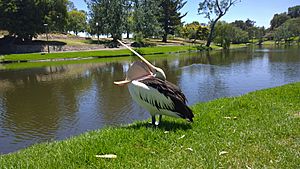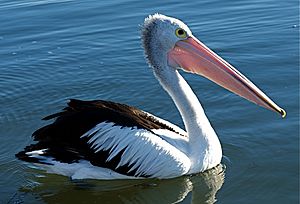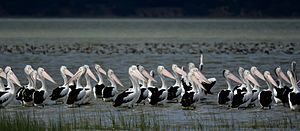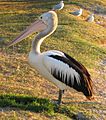Australian pelican facts for kids
Quick facts for kids Australian pelican |
|
|---|---|
 |
|
| Conservation status | |
| Scientific classification | |
| Genus: |
Pelecanus
|
| Species: |
conspicillatus
|
 |
|
| blue : nonbreeding green : year-round |
|
The Australian pelican (Pelecanus conspicillatus) is a very large waterbird. It belongs to the pelican family. You can find these birds all over Australia and New Guinea. They also live in Fiji and parts of Indonesia. Sometimes, they even visit New Zealand.
This pelican is mostly white with black wings. It has a long, pink bill. In fact, it has the longest bill of any living bird! Australian pelicans mainly eat fish. But they can also eat other birds or find food scraps if they need to.
Contents
About the Australian Pelican
The Australian pelican was first described by a Dutch scientist named Coenraad Jacob Temminck in 1824. Its scientific name, conspicillatus, comes from a Latin word meaning 'to behold'. This refers to the 'spectacled' look around its eyes.
What Does it Look Like?
The Australian pelican is a medium-sized pelican. Its wings can spread out from 2.3 to 2.6 meters (7.5 to 8.5 feet) wide. These birds usually weigh between 4.54 and 7.7 kilograms (10 to 17 pounds). The average weight is about 5.5 kilograms (12 pounds). This makes it the heaviest flying bird in Australia.
Its pale, pinkish bill is huge. It is the longest bill of any bird in the world. The longest bill ever recorded was 50 centimeters (20 inches) long! Female pelicans are a bit smaller. Their bills are also smaller, sometimes as short as 34.6 centimeters (13.6 inches). The pelican's total length, including its long bill, can be from 152 to 188 centimeters (60 to 74 inches). This makes it one of the longest pelicans.
Most of the Australian pelican's body is white. It has a white patch on its upper wing. There is also a white V-shape on its back. The main wing feathers are black.
When pelicans are ready to find a mate, their bill and eye area change color. The skin around their eyes turns orange. The end of their bill becomes orange. Their pouch can turn dark blue, pink, or scarlet. When they are not breeding, their bill and eye-ring are pale yellow. Their pouch is a light pink. Young pelicans look like adults. But their black feathers are brown instead. The white patch on their upper wing is smaller.
Where They Live
Australian pelicans live in most parts of Australia and Tasmania. They like large areas of open water. This includes big lakes, reservoirs, and rivers. They also live in estuaries, swamps, and temporary flooded areas. You can find them in city parks or even industrial areas. The most important thing is enough open water for food. They prefer quiet places when they are breeding. They also rest on mudflats, sandbars, and beaches.
These pelicans do not follow a set travel plan. They move to find food. If there is a drought, they often move. For example, when Lake Eyre filled with water in 1974-1976, many pelicans gathered there. When the lake dried up, they spread out again. Sometimes, strong winds blow them to new places.
They often visit the southern coast of New Guinea. They also go to the Bismarck Islands and Solomon Islands. Sometimes, they are seen in Christmas Island, Vanuatu, Fiji, Palau, and New Zealand.
What They Eat
Australian pelicans hunt for food by diving into the water while swimming. They often work together in groups. They push fish into shallow water. Then they use their sensitive bills to catch the fish. Some feeding groups can have up to 1,900 birds! They also hunt alone sometimes.
Their main food is fish. They often eat fish like goldfish and European carp. They also eat native fish. But Australian pelicans eat more than just fish. They regularly eat insects and many water crustaceans. This includes yabbies and certain types of shrimp.
These pelicans also eat other birds sometimes. They have been known to eat silver gulls and Australian white ibis. They might eat eggs, baby birds, or even adult birds. They can drown other birds by holding them underwater. Reptiles and amphibians are also part of their diet. Australian pelicans sometimes steal food from other water birds like cormorants.
Life Cycle and Reproduction
Australian pelicans start breeding when they are two or three years old. The breeding season changes depending on the area. In tropical places, it is in winter. In southern Australia, it is in spring. In inland areas, they can breed any time after it rains.
Their nest is a shallow dip in the ground or sand. Sometimes, it has a bit of grass inside. They build grassy platforms at Lake Alexandrina. Pelicans nest together in groups called colonies. These colonies are on islands or sheltered areas near lakes or the sea.
Breeding pelicans lay one to four eggs. Usually, they lay two eggs. The eggs are chalky-white and often look dirty. The eggs hatch after 32 to 35 days. When the chicks hatch, they have no feathers. But they quickly grow soft grey down feathers. The larger chick usually gets more food. The smaller one might not survive. For the first two weeks, the chicks drink liquid food that their parents bring up. For the next two months, they eat fish and small invertebrates. Young pelicans learn to fly when they are about three months old.
Status and Conservation
The Australian pelican is not in danger globally. They are quite common in good habitats. For example, when Lake Eyre flooded in 1990, over 200,000 adult pelicans were breeding there. This species is protected by law. Pollution does not seem to be harming them right now.
In some places, like Monkey Mia in Western Australia, pelicans are used to people. They might even ask for food. But they are very sensitive to human activity when they are nesting. They can live in man-made water areas like reservoirs. But they need places without too much boating. The Australian pelican is listed as a least-concern species on the IUCN Red List. This means they are not currently threatened.
Gallery
-
Some Australian pelicans at the mouth of the McArthur River
-
Artificial feeding at The Entrance, New South Wales
-
Beach roosting at Moreton Island
-
At Tangalooma, during artificial feeding session
-
At Portside Wharf in Brisbane, Queensland
See also
 In Spanish: Pelícano australiano para niños
In Spanish: Pelícano australiano para niños





















